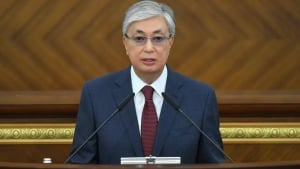
Trump's administration is urging Ukraine to sign a contract for rare metals. This is one of the radical attempts to restore balance in the technological hegemony struggle with China. How effective will the plan be?
In recent weeks, the draft agreement granting concessions for the extraction of critical minerals in Ukraine has been at the center of political debates between official Washington and Kyiv. Critical minerals are essential raw materials for producing green energy systems, semiconductors, batteries, and defense equipment. China is the leader in this industry, controlling more than half of aluminum, lithium, and cobalt production, 90 percent of rare metals, and 100 percent of natural graphite. Additionally, Chile, Indonesia, Russia, the Democratic Republic of Congo, and Argentina also play significant roles in the critical minerals industry.
Donald Trump's push for Ukraine to sign a contract for rare metals is tactical in nature, serving to convince the public for some time that America is focusing on the security of critical minerals. In fact, it also reflects the failure of the policy of technological restraint against China that began during the Biden administration.
China's War on Critical Minerals Against the West
In May 2023, the U.S. imposed restrictions in cooperation with Europe to limit China's technological capabilities. In response, China imposed restrictions on the export of gallium and germanium to unfriendly nations for national security reasons. One of the main reasons for the restrictions on these critical minerals, essential for producing semiconductors, 5G stations, and solar panels, was the Netherlands' restriction on exporting technologies that assist high-level semiconductor production. A year later, in August 2024, China also banned the export of antimony (stibnite), used in military equipment such as infrared missiles and nuclear weapons. Considering that China's share of global extraction of this substance is 48 percent, these bans were painful for the U.S. and its allies.
The former U.S. President Biden's administration imposed restrictions on the supply of high-level chips and chip manufacturing technologies to China on December 2, 2024. In response, on December 3, China intensified existing restrictions on the export of gallium, germanium, and antimony minerals to the U.S. On December 22, China also imposed a ban on the supply of technologies for producing rare metals. This ban was an addition to the previously imposed restrictions on the supply of technologies for extracting and separating rare metals. Finally, in February 2025, China established control over the supply of tungsten, tellurium, molybdenum, bismuth, and indium.
The Importance of Critical Minerals for the U.S.
China's actions have revealed the strategic vulnerability of the U.S. The United States has shown that it is as dependent on China's critical minerals and rare metals as China is on America's high technologies.
Firstly, dependence on critical minerals and rare metals makes the production of advanced military technologies and research on new ones more expensive in the U.S. compared to China. As a result, China's capabilities rise to a higher level in the modern arms race. For example, considering drones, which have become the most important tool of military operations today, critical minerals and rare metals play a crucial role in increasing the flight duration and improving the batteries of these devices. Falling behind in battery technology complicates the U.S.'s ability to compete with China in remote-controlled technologies. This is because the effectiveness of radar systems placed at certain distances to ensure strategic communication depends on batteries.
Secondly, in the clash of economic competition and business interests, China is in a better position than the U.S. For instance, in the electric vehicle industry, BYD is considered a serious competitor to Tesla, which belongs to Trump's close associate Elon Musk. In 2024, BYD held nearly a quarter of the electric vehicle market. This is almost 2.5 times more than Tesla's market share. It is known that the production of electric vehicle batteries depends on critical minerals and rare metals. Alongside batteries, gallium and germanium minerals, which have taken key positions on the list of restrictions, are significant components in the semiconductor industry. Semiconductors, in turn, ensure the efficiency of artificial intelligence systems. This means that just as China is dependent on the U.S. in the microelectronics field, the U.S. also risks being in a complicated situation without China's raw materials.
Actions of the Biden Administration
During Biden's presidency, the U.S. attempted to develop its critical minerals and rare metals industry. For example, from 2020 to 2022, the Biden administration allocated $44.6 million to MP Materials for the process of extracting rare metals and producing magnets, and $150.4 million to Lynas Rare Earths to develop rare metal extraction capabilities. Additionally, Washington took several other measures:
1. Applying the Defense Production Act (DPA): This aims to accelerate the extraction and processing of lithium, nickel, cobalt, graphite, and manganese for EV batteries;
2. Allocating funds for battery production. $3 billion was allocated to increase battery production across 14 states for 25 projects and reduce dependence on foreign supply;
3. Approving domestic lithium extraction projects. Approval of the Ioneer lithium extraction project in Nevada, which will produce lithium for 370,000 electric vehicles annually;
4. Strengthening reserves of critical minerals. A plan to create reserves of nickel and cobalt to reduce China's dominance in mineral supply;
5. Increasing tariffs on imports from China. Doubling and tripling customs tariffs on solar panels and lithium-ion batteries imported from China;
6. Implementing the Infrastructure Investment and Jobs Act. $1 billion allocated for creating rare earth mineral reserves, and $3 billion for processing and recycling;
7. Issuing an executive order on American supply chains. Conducting a 100-day analysis to identify vulnerabilities in critical mineral supply chains;
8. Granting funds for rare earth element extraction. Allocating $16 million to universities for research on extracting rare earth elements from coal ash and mining waste;
9. Reviewing financial support for critical mineral projects. Setting minimum prices and considering other financial assistance mechanisms to support critical mineral extraction projects in America.
Will Trump's Plan Work?
Although the above actions taken by the Biden administration are strategically significant, they were not sufficient to establish a competitive critical minerals and rare metals industry in the U.S. Unlike Joe Biden, Donald Trump chose to approach the critical minerals sector with a radical and tactical style, as he did in other areas. For example, although Trump's proposal to relocate the Gaza population is quite drastic, it does not resolve the issue related to Israel in the Middle East. With this proposal, Trump merely prevents the ultra-right forces led by Smotrich from leaving Netanyahu's coalition and helps Netanyahu remain in government. This, in turn, partially extends the current government's lifespan.
Donald Trump's proposed contract with Ukraine regarding critical minerals and his plan to annex Greenland are also radical and tactical in nature, which may not ensure U.S. superiority in competition with China.
Firstly, China has a significant advantage over the U.S. not only in extracting critical minerals but also in the machines that produce them. Just as China needs to catch up with the U.S. in lithography technology, the U.S. must catch up with China in the industry of technologies that produce critical minerals. However, controlling the critical mineral reserves in Ukraine and Greenland does not solve the problem related to production technologies.
For instance, the seabed and ocean floor are legally neutral areas for mineral extraction, which all countries can utilize. However, the U.S. currently lacks sufficient technical and technological potential to carry out such practices. The problem for the U.S., which demands mineral resources from Ukraine and Greenland, is not the lack of regions with mineral reserves but the lack of competitive techniques and technologies to extract them.
Secondly, the active public in the U.S. may resist mining practices harmful to nature more strongly than the public in China or other developing countries. This is because the green energy is not as green as envisioned. Therefore, the U.S. faces difficulties in bringing this industry into its territory. However, it should not be forgotten that public opinion has also formed in Greenland and Ukraine, and ecological expansion may lead to protests against the activities of U.S. mining companies, potentially reducing the industry's efficiency.
Finally, even if the process of extracting mineral resources in Greenland and Ukraine begins, it is uncertain whether U.S. companies will be able to successfully establish mining practices. This is due to several obstacles, such as the lack of cheap and skilled labor in this industry, the possibility of Russia launching a new attack in Ukraine, the risk of the freedom movement in Greenland, and the need to compete with Chinese firms that have adapted to the industrial chain. To compete with Chinese firms already active in the critical minerals industry, American companies will need to receive numerous privileges and assistance from the government.
In turn, these forms of assistance may negatively impact the federal budget and liberal market rules. Additionally, a victory for the Democrats in the 2026 Congressional elections may halt Donald Trump's aggressive approach. In such a case, American companies will remain at risk in establishing long-term plans in the critical minerals sector. As a result, the national critical minerals and rare metals industry is decreasing the likelihood of becoming an attractive business for local companies in the U.S.
Expectations Regarding U.S. Policy on Critical Minerals and Rare Metals
The United States may pursue policies in the following directions to address its issues in the critical minerals and rare metals industry.
Aggressive Expansion. This character, currently manifested in U.S. President Donald Trump's foreign policy, encourages the United States to take control of mineral reserves directly or with the help of pro-American forces. The direct involvement of the U.S. would jeopardize the existing world order and bring back colonial approaches from the 19th century to the political arena. The desire of the American business elite to meet the demand for minerals may pass on to the political elite and, through propaganda, to the American people.
This could lead to a sharp division in domestic politics between liberal and democratic factions and supporters of colonialist views. On the other hand, expansionist policies could be implemented with the help of pro-American forces. This resembles the oil wars of the 20th century. As a result, new centers of political and military conflicts may emerge beyond the Middle East. These could potentially be Southeast Asia and Africa.
Approaching Russia. Russia is unable to fully utilize its resources due to sanctions limiting its technological capabilities and trade restrictions. Washington has the opportunity to address both issues. Warming relations between the White House and Russia could alleviate the mineral resource-related problems in the U.S.
In this way, Washington would not only open a new supply route in the minerals industry but also turn Russia and China into mutual competitors. On the other hand, the U.S.'s dependence on external supply would remain. This is similar to how European countries at the beginning of the 21st century purchased energy resources from Russia. This measure could yield short-term results until Moscow demonstrates its political ambitions.
Stopping Trade Wars. To stop trade wars, Washington must address the fundamental issues in the technology sector. American technology companies, which have grown under a single order since 1991, are struggling to adapt to the multipolar world rules that have formed after a quarter of a century. In a world where the rules previously stated by Washington prevailed, each state is now implementing its internal regulations for the technology market and cyberspace. In this situation, mere innovation is not enough.
American companies must also compete in diplomacy and pricing. As a result, the high cost of labor and the active geopolitical position of the U.S. have begun to negatively impact these characteristics. A relatively moderate foreign policy and cheap labor are giving an advantage to China. The U.S. political elite, which cannot provide a competitive internal environment and favorable foreign policy for technology companies, has ultimately openly entered into trade wars with foreign countries. The restrictions imposed in response to U.S. sanctions have also affected the minerals industry.
At the same time, another issue is emerging. American technology companies, primarily grown after the Cold War, lack the desire and courage to compete with international rivals. Consequently, the government is forced to announce various tariffs and sanctions to assist companies. To stop trade wars—at least in the technology sector—Washington must conduct effective internal reforms. Otherwise, polarization will continue to rise, and the likelihood of expansionist sentiments will remain high.
Shahboz Jo'rayev, independent researcher







